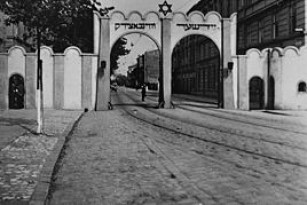
Even though the Nazi occupation of Poland during the Second World War did not destroy Krakow, the city’s urban landscape was nonetheless transformed by the occupying forces.
One of these transformations was the establishment of the Krakow ghetto at one of the five major metropolitan Jewish ghettos created in the new General Government territory during the Nazi occupation of Poland.
Here is everything you need to know about the fascinating and tragic story of Krakow Ghetto.
How many Jews lived in Krakow before the Second World War?
Before the combined German and Soviet invasion of Poland in 1939, Krakow was an essential metropolitan center for the Jewish community.It was populated by 60,000-80,000 Polish Jews whose ancestors started to populate the city in the 13th century.
The members of Krakow’s Jewish community began to be persecuted immediately after the German troops entered the city during the invasion, on September 6, 1939. It’s during that same month that the Nazi occupant ordered Jews to report for forced labor – for example, cleaning the streets from snow during the cold winter months.
Two months later, in November, all Jewish inhabitants of the city who were at least 12 years old were required to wear special armbands bearing the yellow Star of David that would symbolize their identity. The Nazis also closed synagogues and confiscated Jewish relics and valuables cherished by the community.
The NSDAP party leader of the regional branch for Krakow, Hans Frank, decided that Krakow shall become the racially cleanest city in the General Government. His announcement in the mid-1941 resulted in a series of deportations of Jews from the city.
The Jewish population of Krakow was decimated as out of the over 60,000 Jews, only 15,000 workers with their families were permitted to remain in the city. Other members of the Jewish community had to leave the town or were forcibly resettled into the surrounding rural area.
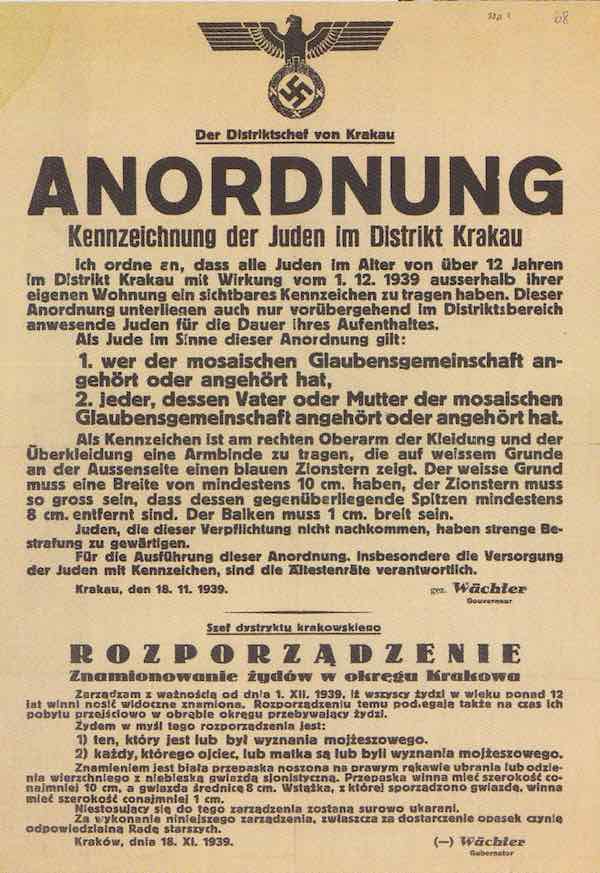
Why was the Krakow ghetto established?
The primary objective of establishing the ghetto in Krakow was terror, exploitation, and persecution of local Jewish communities. The Krakow ghetto also served to separate those who were able to work and contribute to the national economy from those who were deemed unworthy of being alive. Ultimately, closing off Jews in a walled area of the city helped the Nazis control the community and organize its gradual extermination.
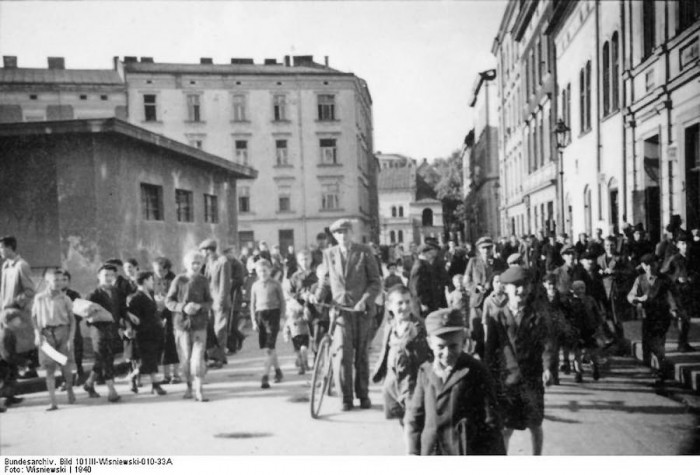
When did the Krakow ghetto operate?
The Krakow ghetto was officially established on March 3rd, 1941. From May 1942 onwards, the Nazi authorities began mass deportation from the ghetto to the surrounding concentration camps.
During the succeeding months, they transported thousands of Jews to the camps as part of the so-called Aktion Krakau.
The Nazis would first assemble the members of the Jewish community on a square and then escort them to the railway station. Historical sources indicate that the first transport out of the city was of around 7 000 people and the second an additional 4 000 taken to the Belzec death camp.
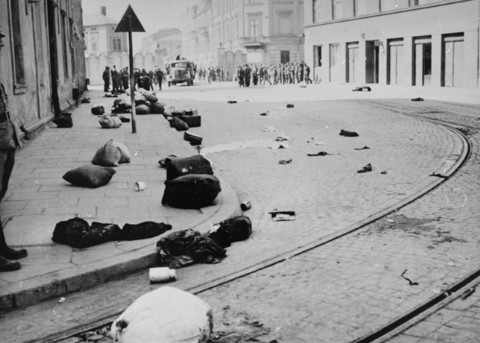
The final liquidation of the ghetto occurred on 13-14 March 1943, a little more over two years after its establishment. The remaining 8 000 Jews who were deemed as able to work were then transported to the Plaszow concentration camp. Those who were considered as unfit for work were killed on the streets of the ghetto during the following days. In total, 2 000 members of the Jewish community lost their lives, and any remaining Jews were simply sent to Auschwitz.
Where was the Krakow ghetto?
The Krakow ghetto was not located, as is often believed, in the historic Jewish district of Kazimierz. Instead, it was formally established in the Podgorze district. To make space for the ghetto, Polish families who lived in the neighborhood took residences in the dwellings that used to be occupied by the Jewish inhabitants of the city, now relocated to the newly established ghetto.
Note that the city authorities crowded 15 000 people in an area that was previously inhabited by only 3 000 people. That’s five times more than the district was prepared for. In total, the district of Podgorze comprised 33 320 buildings and a total of 3 167 rooms. As a result, every four Jewish families were allocated one apartment, and many of the less fortunate were forced to live on the streets.
Jewish Ghetto Krakow Map
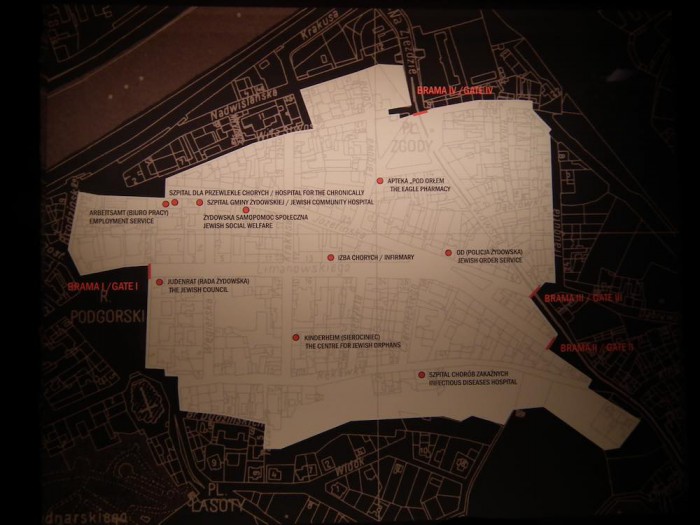
The ghetto was located inside a newly built wall that ensured to keep it separate from the rest of the city. All windows and doors that would open to the non-Jewish side of the town where walled up.
The ghetto had a total of 4 guarded entrances that allowed its inhabitants to pass in or out. If you visit the district, you’ll be able to see small remaining sections of that wall, and one of them is fitted with a commemorative plate that reads ‘Here they lived, suffered and perished at the hands of Hitler’s executioners. From here they began their final journey to the death camps’.
What were the rules of living in the Krakow ghetto?
Jews who were transported to the ghetto were at first allowed to enter and leave it freely. However, several weeks after the transfer was completed – in April 1941 – the gates of the ghetto became closed, and nobody could leave it without a special permit. In general, the gates were guarded by Polish and German police assisted by local Jewish police formation.
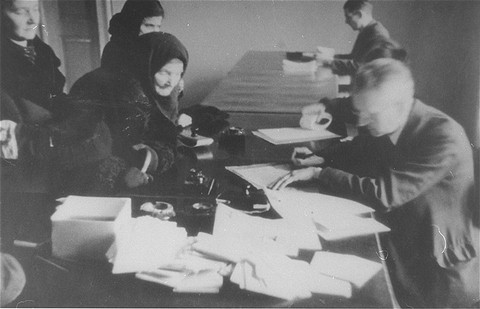
Krakow Ghetto Facts
- People moving to the ghetto were allowed to take only 30 kg of possessions – the rest needed to be handed over to the Germans.
- The Nazi government established a Labor Office in the ghetto and – since around 60% of the population was employed outside of the ghetto – each worker would receive a permit to leave the ghetto and have their identity card renewed every month.
- The Labor Office also decided on their wages to be around 4-5 zloty per day which was at the time equivalent to 1 kg of bread.
- The Jewish community living in the ghetto had no control over their lives. For example, in January 1942, the security police officers entered the ghetto and ordered all inhabitants to hand over their woolen garments and fur, threatening to shoot anyone who refused to comply with that order.
- Single arrests of Jews happened daily, and those who were arrested were taken to prison and then sent to Auschwitz.
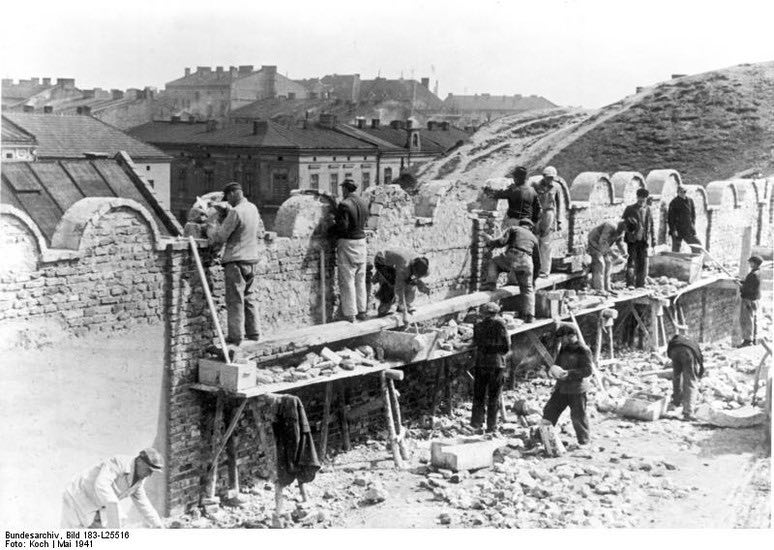
How did people manage to live in the Krakow ghetto?
- To provide employment for the inhabitants of the ghetto, there the authorities set up workshops where German factories sent in raw materials and issued production orders.
- Later on, the area of the ghetto was reduced while the number of inhabitants grew because all Jews who lived in the greater Krakow area (that incorporated 29 villages in the vicinity) were forced to move there too. Consequently, it became overcrowded as each person was granted a mere 4 m³ of space.
- While some inhabitants managed to live in the ghetto, the only sure way to survive was to escape. That was the fate of the Polish author and artist, Roma Ligocka, whose mother managed to buy false ID papers, assumed a new Polish name and dyed her daughter’s hair dark blonde.
- They posed as relatives of a family that took them in but lived in constant fear that someone would discover their real identities. For that measure, they always carried cyanide pills, preferring a quick death to days or months of suffering in a death camp.
The most popular choices
Who helped the Jews in the Krakow ghetto?
One of the most significant figures in the Krakow ghetto history was Tadeusz Pankiewicz. He owned the only pharmacy within the boundaries of the ghetto. The Polish Roman Catholic pharmacist was allowed by the Nazi authorities to operate his pharmacy upon his request. He was responsible for distributing the medications supplies to the residents of the ghetto, and he often did that free of charge.
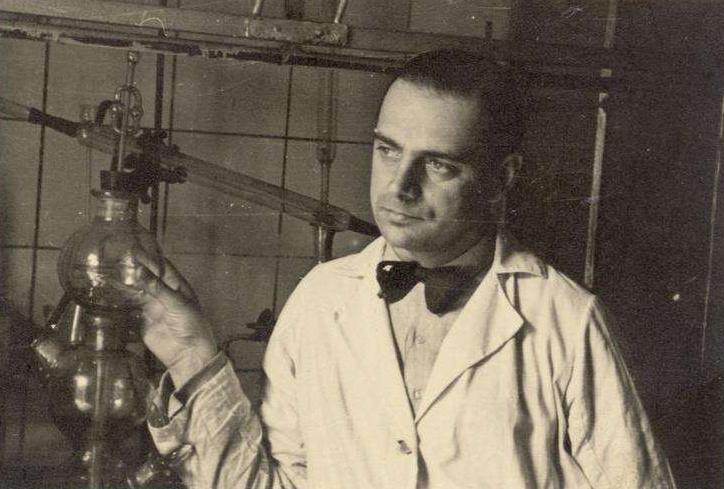
Pankiewicz contributed to the survival of Jews in many different ways. For example, he passed around hair dyes to help Jews who wanted to cross the ghetto walls illegally. Pankiewicz also wrote a book where he chronicled the life in the ghetto – among others, describing the events that occurred during the mass deportations. To recognize his heroic deeds and help he delivered to countless members of the Jewish community locked in the ghetto during the Holocaust, he was given the title of the Righteous Among the Nations by Yad Vashem.
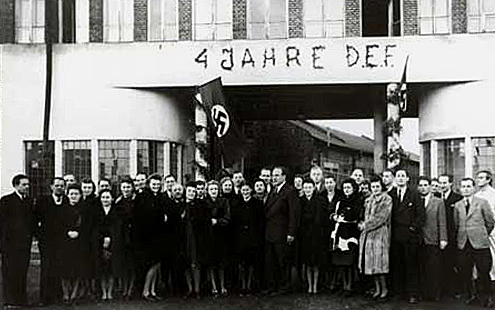
Pankiewicz wasn’t the only Polish citizen of Krakow who helped the Jewish community survive life in the ghetto or escape its confines. Other notable figures include Maria and Bronislaw Florek who smuggled forged identity papers prepared at Oskar Schindler’s Emalia Factory for Jews hiding outside of the ghetto.
Another famous figure is Wladyslaw Budynski who helped numerous members of the Jewish community. He even married a Jewish woman, and upon being discovered by Gestapo, they both were deported to different concentration camps – however, they survived and reunited in Krakow after the war ended.
Who were the most famous residents of the Krakow ghetto?
One of the most famous people who grew up in the Krakow ghetto is none other than Roman Polanski, the world-renowned film director. Polanski was merely 8 years old when the Krakow ghetto was established. In 1984, Polanski wrote a memoir documenting his memories from the childhood spent in the ghetto before the beginning of mass deportations. The book entitled Roman offers a fascinating first-hand account of life in the ghetto – it’s available in English, and you can pick it up on Amazon.

Another famous inhabitant of the Krakow ghetto is the author and artist Roma Ligocka, Polanski’s first cousin who was rescued from the ghetto as a little girl. Her novel The Girl in the Red Coat: A Memoir documents her memories of life in the ghetto.
Note: many people think she is the girl portrayed by Spielberg in the famous film Schindler’s List, while in fact the image was constructed on the basis of memories a survivor shared with Spielberg beforehand.
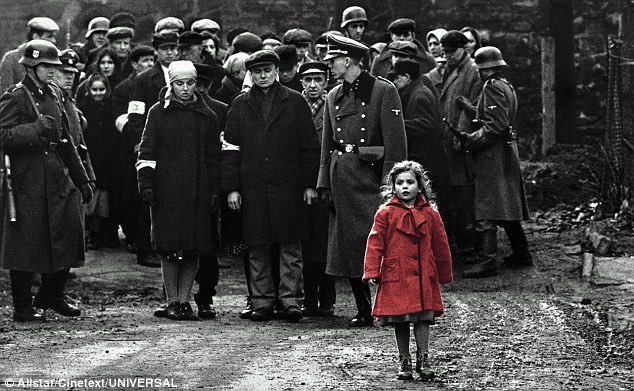
Among other notable writers who survived the Krakow ghetto are Mordechai Gebirtig and Miriam Akavia.
What are the most important events in Krakow ghetto history?
- In March 1942, The SS and police deported 1 500 Jews from the ghetto to the Belzec death camp.
- The following year, they deported up to 7 000 Jews. The Plaszow camp staff killed almost 1 000 of them before the train resumed its journey to Belzec. A few months later, another deportation took place – this time of around 6 000 people. At least 600 were killed during the operation in the ghetto, and 300 of them were children. After selection of individuals suited for labor, the SS sent the overwhelming majority of Jews on this transport to the Belzec death camp.
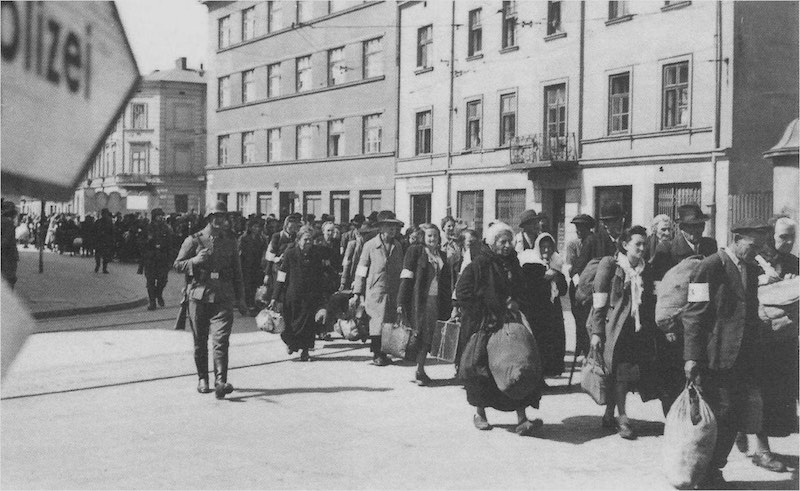
- At the end of 1942, the members of the Jewish Fighting Organization (the underground resistance group in the ghetto) teamed up with the partisan fighters from the Communist People’s Army and attacked Café Cyganeria, an establishment that catered to the German military. Several Germans were killed during that attack.
- The final important event in the life of the Krakow ghetto was its liquidation. Around 2 000 Jews were killed during the operation by the SS, and another 2 000 were transferred to Plaszow concentration camp. The SS transported another 3 000 to Auschwitz-Birkenau, where 499 men and 50 women were selected for forced labor and the rest killed in the gas chambers.
Krakow Ghetto – An Important Piece of Krakow’s History
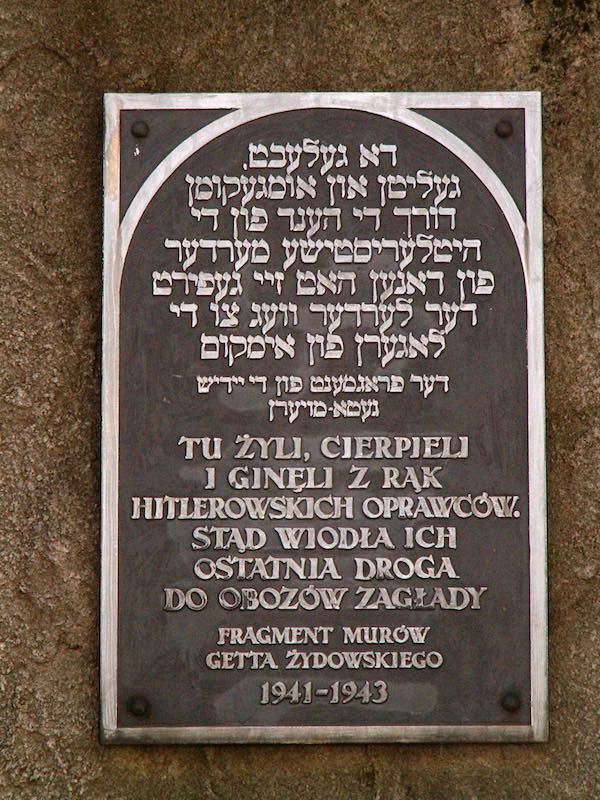
It’s impossible to visit Krakow today without remembering the long and at times disastrous history of the city. Even though the Krakow ghetto is today recognized as one of the most tragic events in the city’s history, it’s important to remember it and commemorate the losses Krakow’s Jewish community suffered during the Nazi occupation.
The history of Jews in Krakow – marked by their disappearance from what today is a fashionable district of Kazimierz – is tightly woven into the history of the city itself. If you are more interested in Jewish culture – check out our blog post.
Discover the remnants of the Krakow ghetto and explore the Jewish district of Kazimierz to learn more about European history and appreciate the heroic actions of people who risked their lives to help those in need.
